Association in a 2 2 Table
|
| < Day Day Up > |
|
Association in a 2 × 2 Table
The most basic table is a 2 × 2 table. Usually, the columns represent some sort of outcome, often yes or no, and the rows represent levels of a factor that may influence the outcome. Suppose, for example, that researchers were investigating the properties of a new "ouchless" Band-Aid for children. Interest lies in whether those children trying the test Band-Aid recorded fewer complaints on removal than those children using a regular Band-Aid. You can address this question by forming the two-way table of Band-Aid type and complaint status and then assessing the association between the rows and columns of that table.
Open the Bandaid Data Set
These data are provided as the Bandaid data set in the Analyst Sample Library. To open the Bandaid data set, follow these steps:
-
Select Tools → Sample Data...
-
Select Bandaid.
-
Click OK to create the sample data set in your Sasuser directory.
-
Select File → Open By SAS Name...
-
Select Sasuser from the list of Libraries.
-
Select Bandaid from the list of members.
-
Click OK to bring the Bandaid data set into the data table.
Figure 9.2 displays the data table containing these data. Note that the data are in frequency form, with the variable count containing the frequencies of the profile contained in each row of the table. The variable type is the type of Band-Aid tested and the variable outcome is the status of complaints.
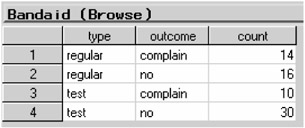
Figure 9.2: Data Set Bandaid in the Data Table
Specify the Table
To construct the appropriate two-way table and request tests of association, follow these steps:
-
Select Statistics → Table Analysis...
-
Select type from the candidate list as the Row variable.
-
Select outcome from the candidate list as the Column variable.
-
Select count from the candidate list as the Cell Counts variable.
Figure 9.3 displays the resulting dialog.
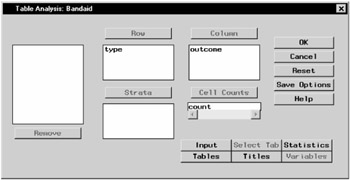
Figure 9.3: Table Analysis Task for Band-Aid Study
Request Tests and Measures of Association
By selecting the rows and columns of the table, you have requested the construction of a 2 × 2 table. To request chi-square tests of association and the odds ratio, which is a measure of association, follow these steps:
-
Click on the Statistics button.
-
Select Chi-square statistics.
-
Select Measures of association.
-
Click OK.
Figure 9.4 displays the Statistics dialog.
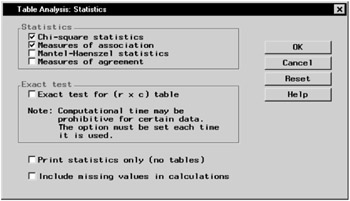
Figure 9.4: Statistics Dialog
Finally, in order to customize the form of the displayed table, follow these steps:
-
Click on the Tables button.
-
Select Observed under Frequencies.
-
Select Row under Percentages.
-
Click OK.
Figure 9.5 displays the resulting Tables dialog.
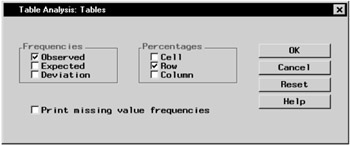
Figure 9.5: Tables Dialog
This requests that only the raw frequencies and the row percentages be listed in the printed table cell.
Click OK in the Table Analysis dialog to perform the analysis.
Review the Results
The frequency table is displayed in Figure 9.6. Note that 46 percent of those children getting regular Band-Aids had complaints about irritation when their Band-Aid was removed, compared to 25 percent of those children receiving the test Band-Aid.
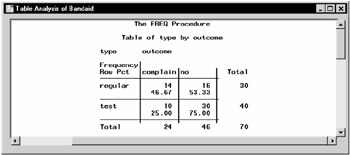
Figure 9.6: Frequency Table for Bandaid Data
Figure 9.7 contains the table of computed chi-square statistics for this table. The Pearson chi-square statistic, labeled "Chi-Square," has a value of 3.57 and an associated p-value of 0.0588 with 1 degree of freedom. If you were doing strict hypothesis testing, you would not reject the hypothesis of no association at the α = 0.05 level of significance. However, researchers in this case found enough evidence in this pilot study to continue looking into the new product.
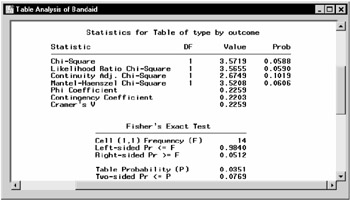
Figure 9.7: Chi-Square Statistics for Bandaid Data
Several other chi-square statistics also appear in this output, such as the likelihood ratio chi-square and the Mantel-Haenszel chi-square. These statistics are asymptotically equivalent.
Figure 9.8 contains the table of relative risk estimates including the odds ratio, which is labeled "Case-Control." The odds ratio is the ratio of the odds of having an outcome for one group versus another. When the odds ratio has the value 1, you have equal odds of having the outcome. When the odds ratio is greater than 1, one group has greater odds of an outcome than the other.
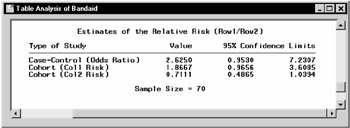
Figure 9.8: Odds Ratio for Bandaid Data
The odds ratio has a value of 2.62, which means that the odds of a complaint are 2.62 times higher for those children using the regular Band-Aid than for those using the test Band-Aid.
|
| < Day Day Up > |
|
EAN: 2147483647
Pages: 116